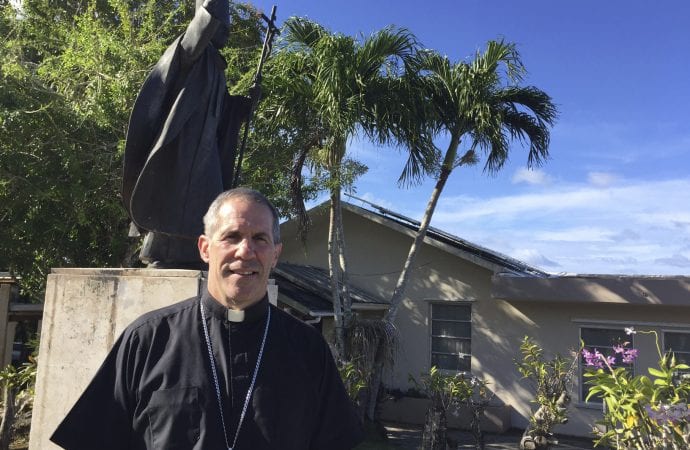A remarkable thing happened in the Archdiocese of Agaña, Guam, about eight weeks after the World Health Organization declared COVID-19 a worldwide pandemic.
On May 2, 2020, thousands of Catholics came out of their homes as a rare procession passed by: A pickup truck took Guam’s revered statue of Santa Marian Kamalen (Our Lady of Camarin) from Dulce Nombre de Maria Cathedral-Basilica in Hagåtña to every parish and village for the first time. She is the patroness of Guam and the Marianas Islands.
“As we were driving steadily through, people were coming out of their homes and they had their own little image of the Santa Marian, and they were crying and throwing flowers,” Archbishop Michael J. Byrnes of Agaña said.
Many also prayed the rosary and sang Marian hymns.
“It was kind of like we had this immediate devastation (the pandemic) and then there was this outpouring of love and faith and grace — that was the beginning,” he told Catholic News Service in a May 18 interview. “We didn’t realize there was going to be a lot of trial and then there was the grace.”
The statue “rarely gets out of the cathedral and the only place you can see it is underneath the crucifix in apse,” he said, but the pastor “devised a great way of honoring” this much-revered statue of Mary — by using a plexiglass box. One was specially created to hold her.
“Early on in the COVID breakout, we has this great opportunity for our island, and so we brought her out,” the archbishop added.
The same day he celebrated a 5 a.m. Mass at the cathedral-basilica to reconsecrate Guam to Mary. The May 2 procession, he noted, also prompted young adult Catholics to start a chat community about it, which they declared “was so awesome.”
This procession with the Marian image was repeated six months later on the feasts of the Immaculate Conception and Santa Marian Kamalen — Dec. 8. Because of pandemic health and safety protocols in place, it was organized in place of the big, traditional procession, novena and rosaries normally attended by thousands in the capital city of Hagåtña every Dec. 8.
The 300-year-old statue survived the bombing of Guam in World War II, numerous super-typhoons, an 8.1 earthquake and being stolen three times.
The image’s resilience may well reflect that of Guam’s Catholics and their strong faith — even during the pandemic.
Byrnes is not worried, like some may be elsewhere, that Catholics now used to livestreamed Mass in lieu of in-person Masses because of COVID-19 health and safety restrictions won’t easily return to their churches.
“You know in Guam, people coming back to Mass is not going to be an issue. Our faithful are pretty strong and the church means more (here) normally, I think, than in in some other places,” he said.
On Pentecost, the archdiocese will lift the general dispensation from the obligation to attend Mass on Sundays and holy days.
Many Catholic dioceses and archdioceses were preparing to fully reopen on the feast of Pentecost, May 23 — and likewise lifting the general dispensation, put in place shortly after the pandemic began.
CNS asked Byrnes if he thought this year, because of the pandemic and the lockdowns, Pentecost has special significance for the faithful with its themes of renewal and breathing new life into the community.
“Yes, I think that’s really true. Pentecost is the birthday of the church. It’s very, very appropriate we lift the dispensations on Pentecost Sunday,” he said.
Throughout the pandemic, the Agana Archdiocese has had a real partnership with civil authorities, including Gov. Lourdes Aflague “Lou” Leon Guerrero, in terms of health and safety needs, restrictions on public spaces and mitigation efforts.
“We decided to partner with the governor. … I kind of barreled in and said we’re going to be partners in this, so if we’re going to be partners, we’re going to get give and take, so that has been a great thing for us,” Byrnes said.
According to data from The New York Times and other sources, the reported COVID-19 cases in Guam number 9,078 to date, with a death toll of 140. The biggest spike in cases there came in November and December. As of May 18, the seven-day average of new cases was nine a day.
The archdiocese was cleared by the Centers for Disease Control and the Guam Department of Health to have in-person Masses.
“We were really strict on the mitigation — exactly 6 feet apart. We did a lot of screening. We worked with the Department of Public Health,” Byrnes said. “We know our people — and most of our people in Guam are Catholic, and so we can actually touch people and not just say, ‘Here are the big numbers’ (of cases).
“We know those numbers, we know those people and that has been a blessing for the church. It has helped the parishes and the pastors to be more attentive to what’s going on here,” he added.
Restrictions on the size of congregations have been in place, he said, and the archdiocese is not going to eliminate them all,” but they “won’t be as necessary.”
The average cap has been 75% indoors and outside churches Catholics have gathered in parking lots, putting chairs — 6 feet apart — where they’d normally park their cars — to listen to Mass.
During Mass at the cathedral-basilica, he said, it is not unusual to go outside to the lanai, or porch, to distribute Communion.
Throughout the pandemic, he said, there has been a hunger for the Eucharist.
“Our people love the Eucharist. They really do. There are so many places that have adoration,” Byrnes said, adding that the faithful may not fully understand the theology of Real Presence, but in their hearts, they know.”
Another blessing for the church in Guam amid the pandemic was the ordinations of three new priests in the final months of 2020.

